Clinical Practice: Self-Reflective Journal on Learning Outcomes
VerifiedAdded on 2023/06/07
|8
|2288
|141
Journal and Reflective Writing
AI Summary
This self-reflective journal provides an analysis of the student's learning experience in clinical practice, focusing on professional practice and the ability to self-assess performance in relation to RN standards. It covers learning outcomes related to clinical decision-making, simulation strategies, and the importance of pattern recognition. The journal also highlights evidence of learning, such as case studies and guidance from senior nurses, as well as the importance of physical assessment and effective communication. The student identifies areas for improvement and proposes actions like maintaining a self-reflective journal, seeking advice from professors, participating in online discussions, and gaining more patient care experience. The overall goal is to enhance knowledge and skills to provide high-quality patient care in the future, utilizing resources like self-help books and case studies.
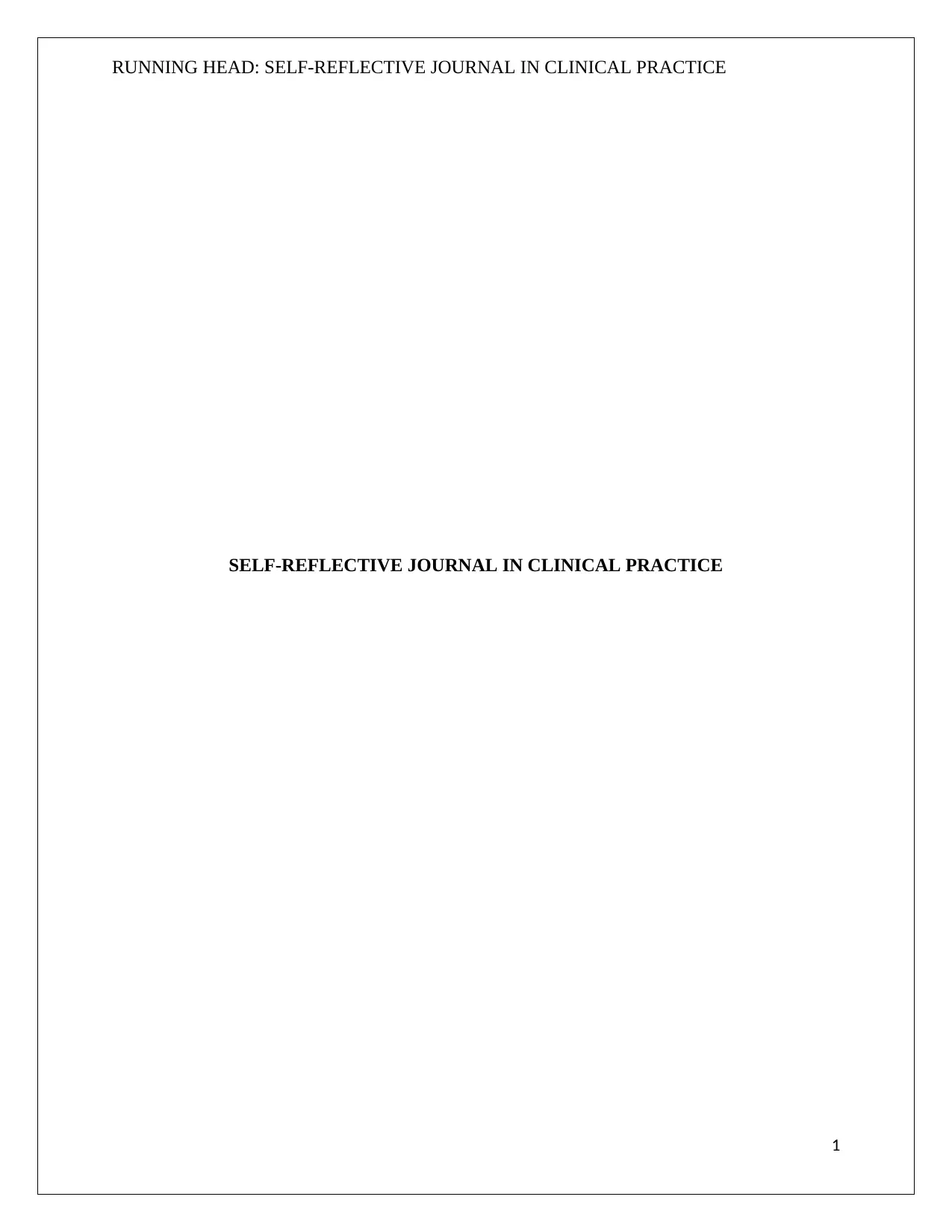
RUNNING HEAD: SELF-REFLECTIVE JOURNAL IN CLINICAL PRACTICE
SELF-REFLECTIVE JOURNAL IN CLINICAL PRACTICE
1
SELF-REFLECTIVE JOURNAL IN CLINICAL PRACTICE
1
Paraphrase This Document
Need a fresh take? Get an instant paraphrase of this document with our AI Paraphraser
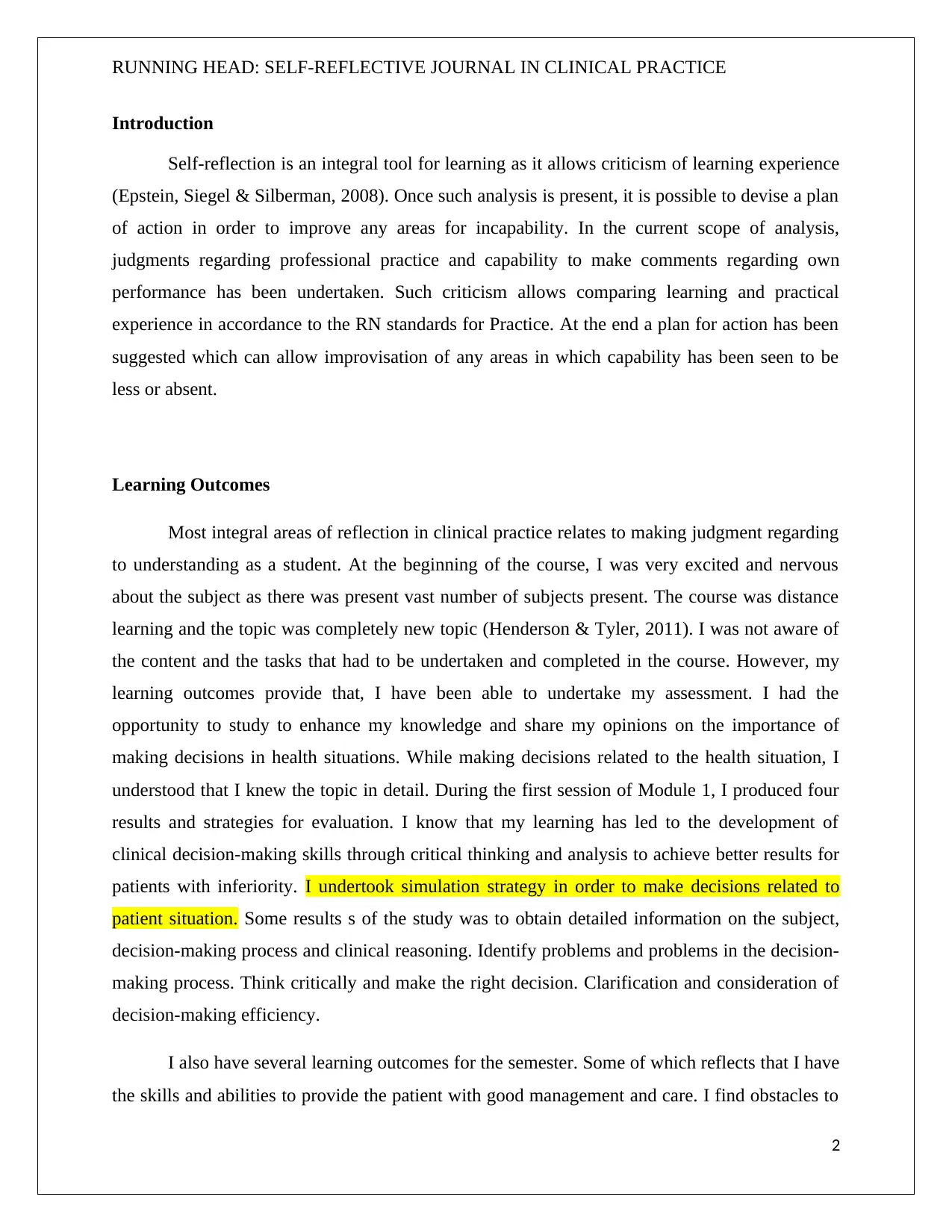
RUNNING HEAD: SELF-REFLECTIVE JOURNAL IN CLINICAL PRACTICE
Introduction
Self-reflection is an integral tool for learning as it allows criticism of learning experience
(Epstein, Siegel & Silberman, 2008). Once such analysis is present, it is possible to devise a plan
of action in order to improve any areas for incapability. In the current scope of analysis,
judgments regarding professional practice and capability to make comments regarding own
performance has been undertaken. Such criticism allows comparing learning and practical
experience in accordance to the RN standards for Practice. At the end a plan for action has been
suggested which can allow improvisation of any areas in which capability has been seen to be
less or absent.
Learning Outcomes
Most integral areas of reflection in clinical practice relates to making judgment regarding
to understanding as a student. At the beginning of the course, I was very excited and nervous
about the subject as there was present vast number of subjects present. The course was distance
learning and the topic was completely new topic (Henderson & Tyler, 2011). I was not aware of
the content and the tasks that had to be undertaken and completed in the course. However, my
learning outcomes provide that, I have been able to undertake my assessment. I had the
opportunity to study to enhance my knowledge and share my opinions on the importance of
making decisions in health situations. While making decisions related to the health situation, I
understood that I knew the topic in detail. During the first session of Module 1, I produced four
results and strategies for evaluation. I know that my learning has led to the development of
clinical decision-making skills through critical thinking and analysis to achieve better results for
patients with inferiority. I undertook simulation strategy in order to make decisions related to
patient situation. Some results s of the study was to obtain detailed information on the subject,
decision-making process and clinical reasoning. Identify problems and problems in the decision-
making process. Think critically and make the right decision. Clarification and consideration of
decision-making efficiency.
I also have several learning outcomes for the semester. Some of which reflects that I have
the skills and abilities to provide the patient with good management and care. I find obstacles to
2
Introduction
Self-reflection is an integral tool for learning as it allows criticism of learning experience
(Epstein, Siegel & Silberman, 2008). Once such analysis is present, it is possible to devise a plan
of action in order to improve any areas for incapability. In the current scope of analysis,
judgments regarding professional practice and capability to make comments regarding own
performance has been undertaken. Such criticism allows comparing learning and practical
experience in accordance to the RN standards for Practice. At the end a plan for action has been
suggested which can allow improvisation of any areas in which capability has been seen to be
less or absent.
Learning Outcomes
Most integral areas of reflection in clinical practice relates to making judgment regarding
to understanding as a student. At the beginning of the course, I was very excited and nervous
about the subject as there was present vast number of subjects present. The course was distance
learning and the topic was completely new topic (Henderson & Tyler, 2011). I was not aware of
the content and the tasks that had to be undertaken and completed in the course. However, my
learning outcomes provide that, I have been able to undertake my assessment. I had the
opportunity to study to enhance my knowledge and share my opinions on the importance of
making decisions in health situations. While making decisions related to the health situation, I
understood that I knew the topic in detail. During the first session of Module 1, I produced four
results and strategies for evaluation. I know that my learning has led to the development of
clinical decision-making skills through critical thinking and analysis to achieve better results for
patients with inferiority. I undertook simulation strategy in order to make decisions related to
patient situation. Some results s of the study was to obtain detailed information on the subject,
decision-making process and clinical reasoning. Identify problems and problems in the decision-
making process. Think critically and make the right decision. Clarification and consideration of
decision-making efficiency.
I also have several learning outcomes for the semester. Some of which reflects that I have
the skills and abilities to provide the patient with good management and care. I find obstacles to
2
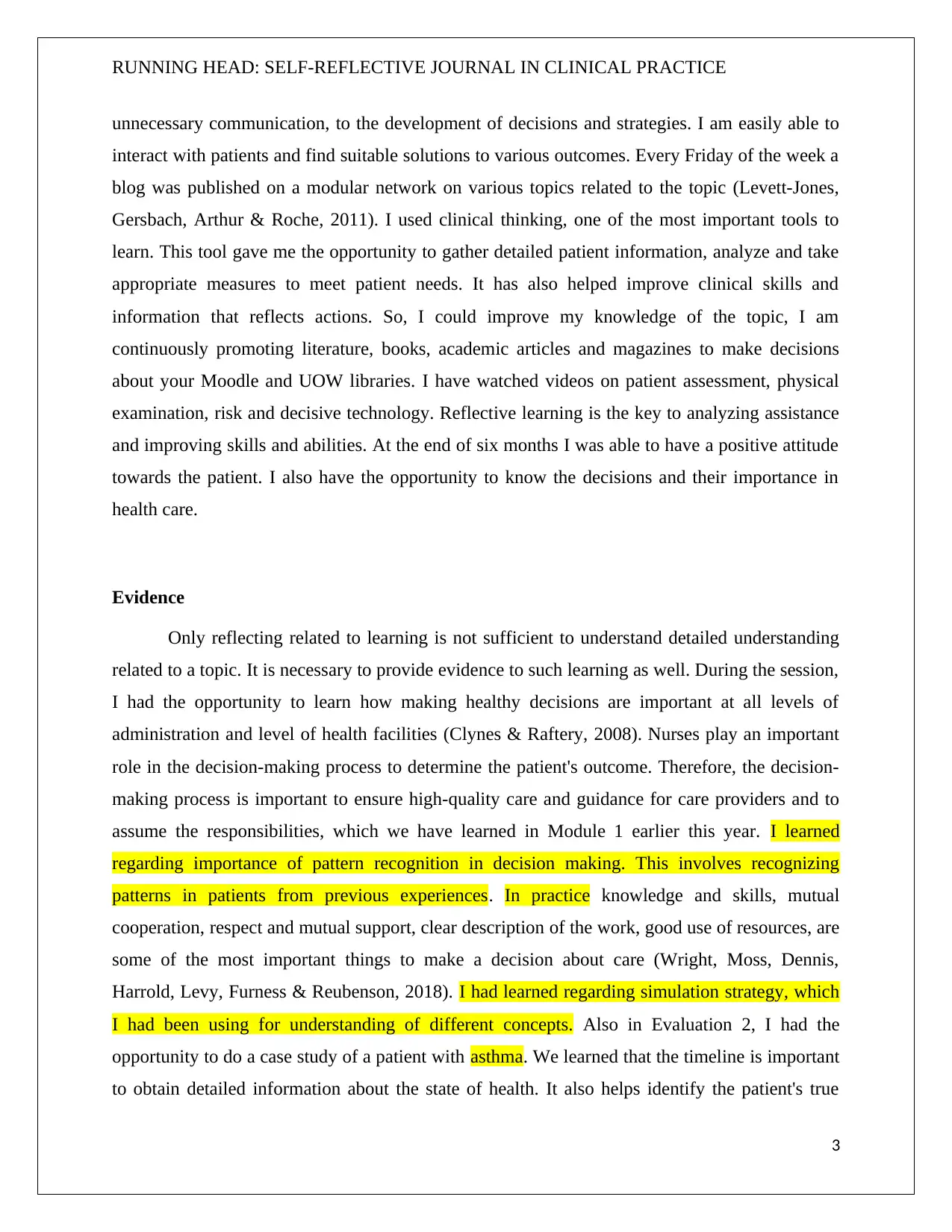
RUNNING HEAD: SELF-REFLECTIVE JOURNAL IN CLINICAL PRACTICE
unnecessary communication, to the development of decisions and strategies. I am easily able to
interact with patients and find suitable solutions to various outcomes. Every Friday of the week a
blog was published on a modular network on various topics related to the topic (Levett-Jones,
Gersbach, Arthur & Roche, 2011). I used clinical thinking, one of the most important tools to
learn. This tool gave me the opportunity to gather detailed patient information, analyze and take
appropriate measures to meet patient needs. It has also helped improve clinical skills and
information that reflects actions. So, I could improve my knowledge of the topic, I am
continuously promoting literature, books, academic articles and magazines to make decisions
about your Moodle and UOW libraries. I have watched videos on patient assessment, physical
examination, risk and decisive technology. Reflective learning is the key to analyzing assistance
and improving skills and abilities. At the end of six months I was able to have a positive attitude
towards the patient. I also have the opportunity to know the decisions and their importance in
health care.
Evidence
Only reflecting related to learning is not sufficient to understand detailed understanding
related to a topic. It is necessary to provide evidence to such learning as well. During the session,
I had the opportunity to learn how making healthy decisions are important at all levels of
administration and level of health facilities (Clynes & Raftery, 2008). Nurses play an important
role in the decision-making process to determine the patient's outcome. Therefore, the decision-
making process is important to ensure high-quality care and guidance for care providers and to
assume the responsibilities, which we have learned in Module 1 earlier this year. I learned
regarding importance of pattern recognition in decision making. This involves recognizing
patterns in patients from previous experiences. In practice knowledge and skills, mutual
cooperation, respect and mutual support, clear description of the work, good use of resources, are
some of the most important things to make a decision about care (Wright, Moss, Dennis,
Harrold, Levy, Furness & Reubenson, 2018). I had learned regarding simulation strategy, which
I had been using for understanding of different concepts. Also in Evaluation 2, I had the
opportunity to do a case study of a patient with asthma. We learned that the timeline is important
to obtain detailed information about the state of health. It also helps identify the patient's true
3
unnecessary communication, to the development of decisions and strategies. I am easily able to
interact with patients and find suitable solutions to various outcomes. Every Friday of the week a
blog was published on a modular network on various topics related to the topic (Levett-Jones,
Gersbach, Arthur & Roche, 2011). I used clinical thinking, one of the most important tools to
learn. This tool gave me the opportunity to gather detailed patient information, analyze and take
appropriate measures to meet patient needs. It has also helped improve clinical skills and
information that reflects actions. So, I could improve my knowledge of the topic, I am
continuously promoting literature, books, academic articles and magazines to make decisions
about your Moodle and UOW libraries. I have watched videos on patient assessment, physical
examination, risk and decisive technology. Reflective learning is the key to analyzing assistance
and improving skills and abilities. At the end of six months I was able to have a positive attitude
towards the patient. I also have the opportunity to know the decisions and their importance in
health care.
Evidence
Only reflecting related to learning is not sufficient to understand detailed understanding
related to a topic. It is necessary to provide evidence to such learning as well. During the session,
I had the opportunity to learn how making healthy decisions are important at all levels of
administration and level of health facilities (Clynes & Raftery, 2008). Nurses play an important
role in the decision-making process to determine the patient's outcome. Therefore, the decision-
making process is important to ensure high-quality care and guidance for care providers and to
assume the responsibilities, which we have learned in Module 1 earlier this year. I learned
regarding importance of pattern recognition in decision making. This involves recognizing
patterns in patients from previous experiences. In practice knowledge and skills, mutual
cooperation, respect and mutual support, clear description of the work, good use of resources, are
some of the most important things to make a decision about care (Wright, Moss, Dennis,
Harrold, Levy, Furness & Reubenson, 2018). I had learned regarding simulation strategy, which
I had been using for understanding of different concepts. Also in Evaluation 2, I had the
opportunity to do a case study of a patient with asthma. We learned that the timeline is important
to obtain detailed information about the state of health. It also helps identify the patient's true
3
⊘ This is a preview!⊘
Do you want full access?
Subscribe today to unlock all pages.

Trusted by 1+ million students worldwide
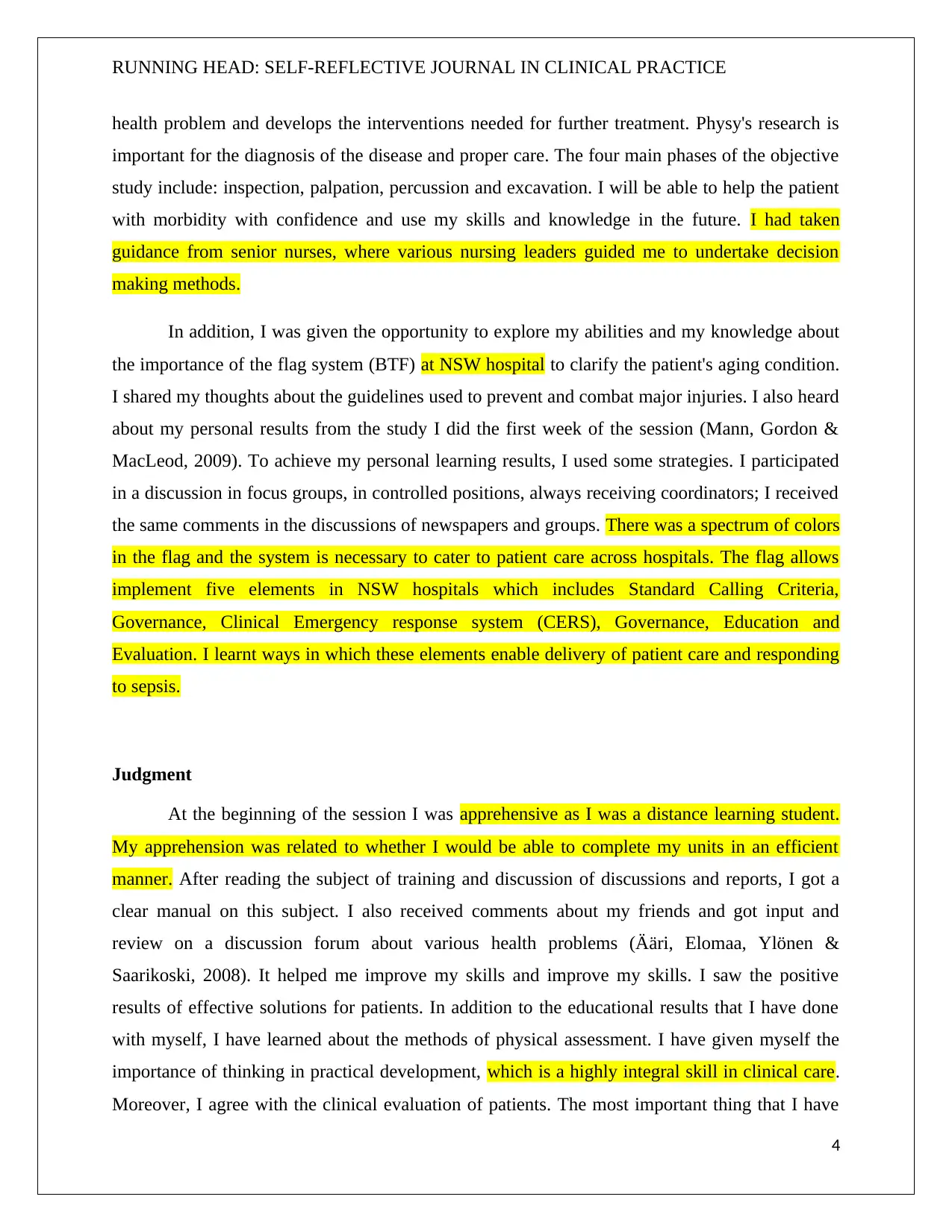
RUNNING HEAD: SELF-REFLECTIVE JOURNAL IN CLINICAL PRACTICE
health problem and develops the interventions needed for further treatment. Physy's research is
important for the diagnosis of the disease and proper care. The four main phases of the objective
study include: inspection, palpation, percussion and excavation. I will be able to help the patient
with morbidity with confidence and use my skills and knowledge in the future. I had taken
guidance from senior nurses, where various nursing leaders guided me to undertake decision
making methods.
In addition, I was given the opportunity to explore my abilities and my knowledge about
the importance of the flag system (BTF) at NSW hospital to clarify the patient's aging condition.
I shared my thoughts about the guidelines used to prevent and combat major injuries. I also heard
about my personal results from the study I did the first week of the session (Mann, Gordon &
MacLeod, 2009). To achieve my personal learning results, I used some strategies. I participated
in a discussion in focus groups, in controlled positions, always receiving coordinators; I received
the same comments in the discussions of newspapers and groups. There was a spectrum of colors
in the flag and the system is necessary to cater to patient care across hospitals. The flag allows
implement five elements in NSW hospitals which includes Standard Calling Criteria,
Governance, Clinical Emergency response system (CERS), Governance, Education and
Evaluation. I learnt ways in which these elements enable delivery of patient care and responding
to sepsis.
Judgment
At the beginning of the session I was apprehensive as I was a distance learning student.
My apprehension was related to whether I would be able to complete my units in an efficient
manner. After reading the subject of training and discussion of discussions and reports, I got a
clear manual on this subject. I also received comments about my friends and got input and
review on a discussion forum about various health problems (Ääri, Elomaa, Ylönen &
Saarikoski, 2008). It helped me improve my skills and improve my skills. I saw the positive
results of effective solutions for patients. In addition to the educational results that I have done
with myself, I have learned about the methods of physical assessment. I have given myself the
importance of thinking in practical development, which is a highly integral skill in clinical care.
Moreover, I agree with the clinical evaluation of patients. The most important thing that I have
4
health problem and develops the interventions needed for further treatment. Physy's research is
important for the diagnosis of the disease and proper care. The four main phases of the objective
study include: inspection, palpation, percussion and excavation. I will be able to help the patient
with morbidity with confidence and use my skills and knowledge in the future. I had taken
guidance from senior nurses, where various nursing leaders guided me to undertake decision
making methods.
In addition, I was given the opportunity to explore my abilities and my knowledge about
the importance of the flag system (BTF) at NSW hospital to clarify the patient's aging condition.
I shared my thoughts about the guidelines used to prevent and combat major injuries. I also heard
about my personal results from the study I did the first week of the session (Mann, Gordon &
MacLeod, 2009). To achieve my personal learning results, I used some strategies. I participated
in a discussion in focus groups, in controlled positions, always receiving coordinators; I received
the same comments in the discussions of newspapers and groups. There was a spectrum of colors
in the flag and the system is necessary to cater to patient care across hospitals. The flag allows
implement five elements in NSW hospitals which includes Standard Calling Criteria,
Governance, Clinical Emergency response system (CERS), Governance, Education and
Evaluation. I learnt ways in which these elements enable delivery of patient care and responding
to sepsis.
Judgment
At the beginning of the session I was apprehensive as I was a distance learning student.
My apprehension was related to whether I would be able to complete my units in an efficient
manner. After reading the subject of training and discussion of discussions and reports, I got a
clear manual on this subject. I also received comments about my friends and got input and
review on a discussion forum about various health problems (Ääri, Elomaa, Ylönen &
Saarikoski, 2008). It helped me improve my skills and improve my skills. I saw the positive
results of effective solutions for patients. In addition to the educational results that I have done
with myself, I have learned about the methods of physical assessment. I have given myself the
importance of thinking in practical development, which is a highly integral skill in clinical care.
Moreover, I agree with the clinical evaluation of patients. The most important thing that I have
4
Paraphrase This Document
Need a fresh take? Get an instant paraphrase of this document with our AI Paraphraser
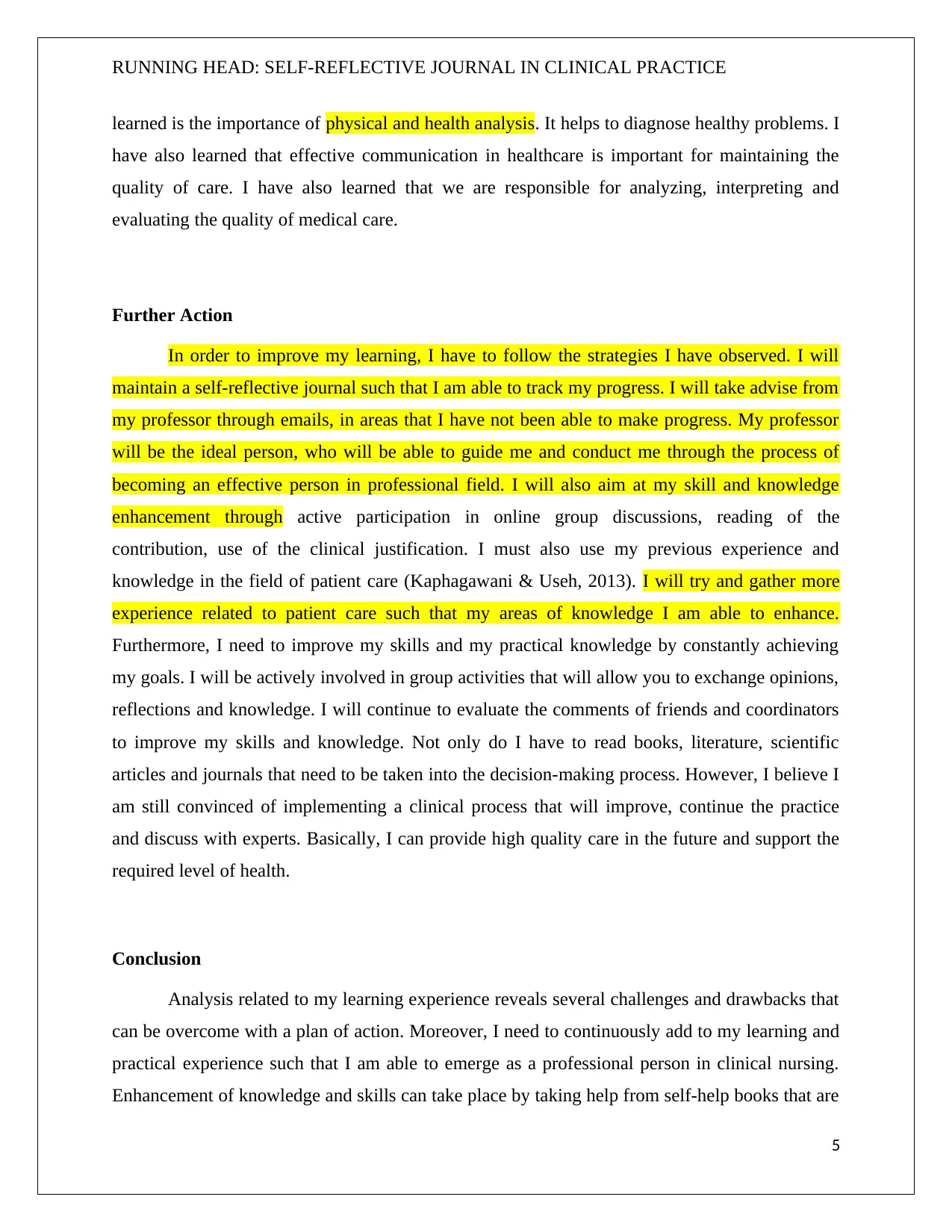
RUNNING HEAD: SELF-REFLECTIVE JOURNAL IN CLINICAL PRACTICE
learned is the importance of physical and health analysis. It helps to diagnose healthy problems. I
have also learned that effective communication in healthcare is important for maintaining the
quality of care. I have also learned that we are responsible for analyzing, interpreting and
evaluating the quality of medical care.
Further Action
In order to improve my learning, I have to follow the strategies I have observed. I will
maintain a self-reflective journal such that I am able to track my progress. I will take advise from
my professor through emails, in areas that I have not been able to make progress. My professor
will be the ideal person, who will be able to guide me and conduct me through the process of
becoming an effective person in professional field. I will also aim at my skill and knowledge
enhancement through active participation in online group discussions, reading of the
contribution, use of the clinical justification. I must also use my previous experience and
knowledge in the field of patient care (Kaphagawani & Useh, 2013). I will try and gather more
experience related to patient care such that my areas of knowledge I am able to enhance.
Furthermore, I need to improve my skills and my practical knowledge by constantly achieving
my goals. I will be actively involved in group activities that will allow you to exchange opinions,
reflections and knowledge. I will continue to evaluate the comments of friends and coordinators
to improve my skills and knowledge. Not only do I have to read books, literature, scientific
articles and journals that need to be taken into the decision-making process. However, I believe I
am still convinced of implementing a clinical process that will improve, continue the practice
and discuss with experts. Basically, I can provide high quality care in the future and support the
required level of health.
Conclusion
Analysis related to my learning experience reveals several challenges and drawbacks that
can be overcome with a plan of action. Moreover, I need to continuously add to my learning and
practical experience such that I am able to emerge as a professional person in clinical nursing.
Enhancement of knowledge and skills can take place by taking help from self-help books that are
5
learned is the importance of physical and health analysis. It helps to diagnose healthy problems. I
have also learned that effective communication in healthcare is important for maintaining the
quality of care. I have also learned that we are responsible for analyzing, interpreting and
evaluating the quality of medical care.
Further Action
In order to improve my learning, I have to follow the strategies I have observed. I will
maintain a self-reflective journal such that I am able to track my progress. I will take advise from
my professor through emails, in areas that I have not been able to make progress. My professor
will be the ideal person, who will be able to guide me and conduct me through the process of
becoming an effective person in professional field. I will also aim at my skill and knowledge
enhancement through active participation in online group discussions, reading of the
contribution, use of the clinical justification. I must also use my previous experience and
knowledge in the field of patient care (Kaphagawani & Useh, 2013). I will try and gather more
experience related to patient care such that my areas of knowledge I am able to enhance.
Furthermore, I need to improve my skills and my practical knowledge by constantly achieving
my goals. I will be actively involved in group activities that will allow you to exchange opinions,
reflections and knowledge. I will continue to evaluate the comments of friends and coordinators
to improve my skills and knowledge. Not only do I have to read books, literature, scientific
articles and journals that need to be taken into the decision-making process. However, I believe I
am still convinced of implementing a clinical process that will improve, continue the practice
and discuss with experts. Basically, I can provide high quality care in the future and support the
required level of health.
Conclusion
Analysis related to my learning experience reveals several challenges and drawbacks that
can be overcome with a plan of action. Moreover, I need to continuously add to my learning and
practical experience such that I am able to emerge as a professional person in clinical nursing.
Enhancement of knowledge and skills can take place by taking help from self-help books that are
5
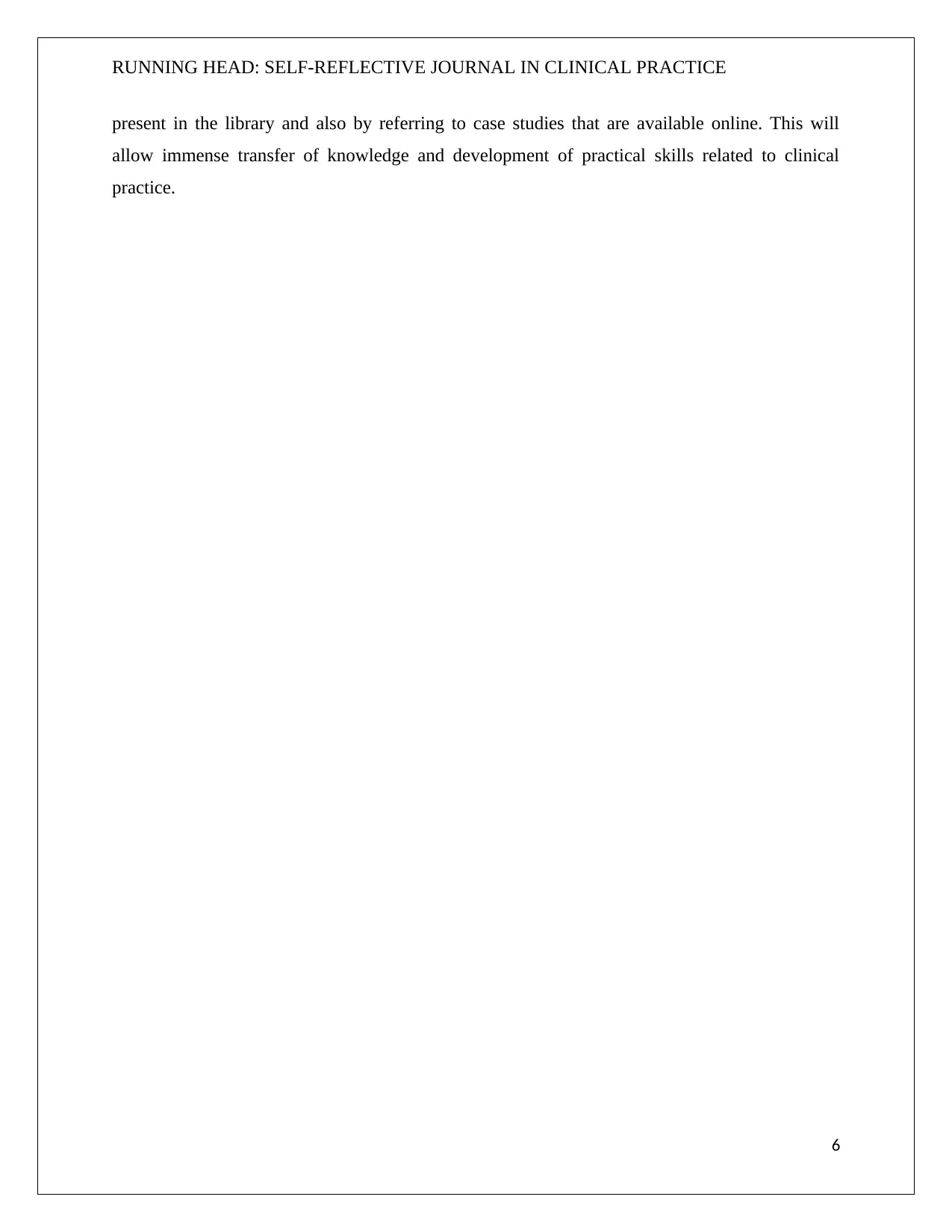
RUNNING HEAD: SELF-REFLECTIVE JOURNAL IN CLINICAL PRACTICE
present in the library and also by referring to case studies that are available online. This will
allow immense transfer of knowledge and development of practical skills related to clinical
practice.
6
present in the library and also by referring to case studies that are available online. This will
allow immense transfer of knowledge and development of practical skills related to clinical
practice.
6
⊘ This is a preview!⊘
Do you want full access?
Subscribe today to unlock all pages.

Trusted by 1+ million students worldwide
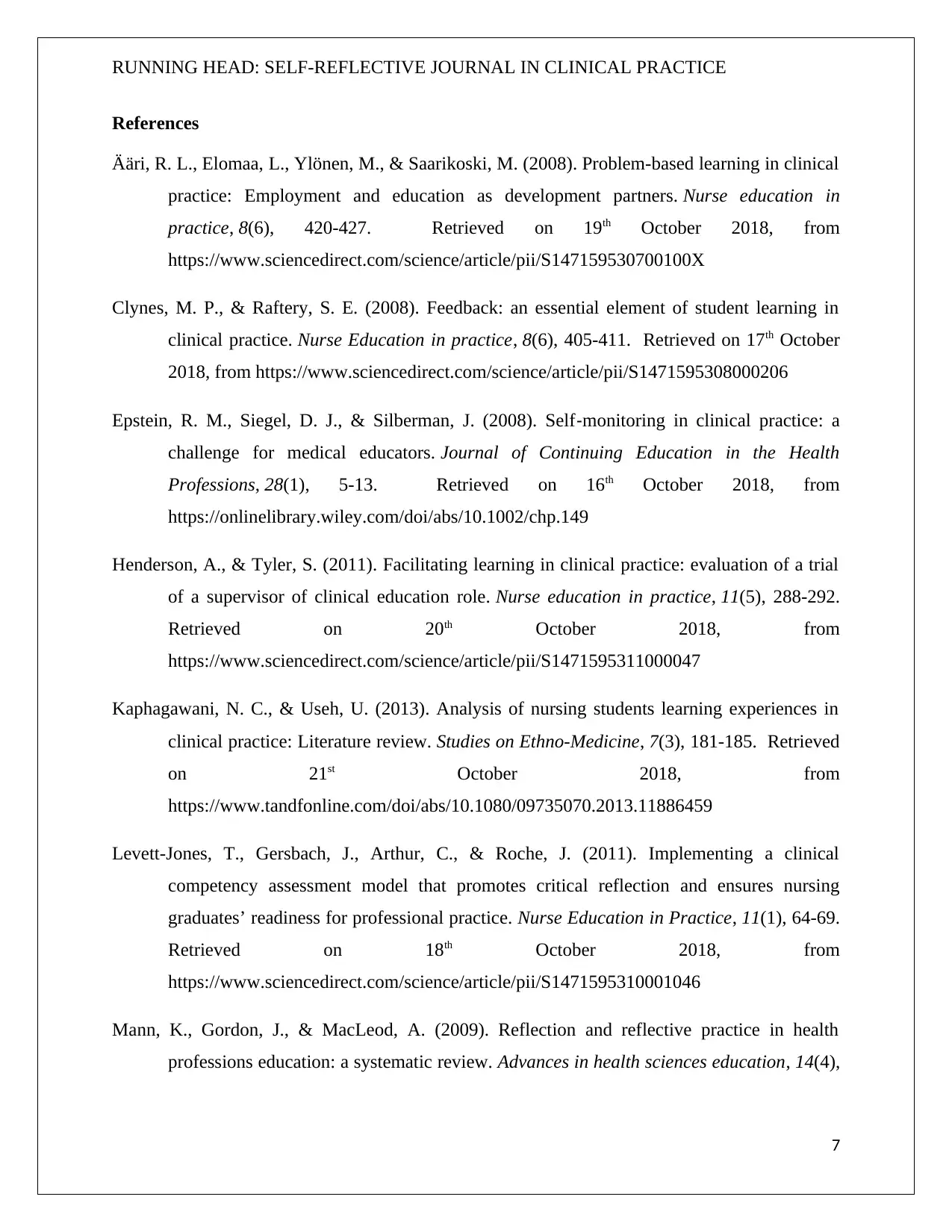
RUNNING HEAD: SELF-REFLECTIVE JOURNAL IN CLINICAL PRACTICE
References
Ääri, R. L., Elomaa, L., Ylönen, M., & Saarikoski, M. (2008). Problem-based learning in clinical
practice: Employment and education as development partners. Nurse education in
practice, 8(6), 420-427. Retrieved on 19th October 2018, from
https://www.sciencedirect.com/science/article/pii/S147159530700100X
Clynes, M. P., & Raftery, S. E. (2008). Feedback: an essential element of student learning in
clinical practice. Nurse Education in practice, 8(6), 405-411. Retrieved on 17th October
2018, from https://www.sciencedirect.com/science/article/pii/S1471595308000206
Epstein, R. M., Siegel, D. J., & Silberman, J. (2008). Self‐monitoring in clinical practice: a
challenge for medical educators. Journal of Continuing Education in the Health
Professions, 28(1), 5-13. Retrieved on 16th October 2018, from
https://onlinelibrary.wiley.com/doi/abs/10.1002/chp.149
Henderson, A., & Tyler, S. (2011). Facilitating learning in clinical practice: evaluation of a trial
of a supervisor of clinical education role. Nurse education in practice, 11(5), 288-292.
Retrieved on 20th October 2018, from
https://www.sciencedirect.com/science/article/pii/S1471595311000047
Kaphagawani, N. C., & Useh, U. (2013). Analysis of nursing students learning experiences in
clinical practice: Literature review. Studies on Ethno-Medicine, 7(3), 181-185. Retrieved
on 21st October 2018, from
https://www.tandfonline.com/doi/abs/10.1080/09735070.2013.11886459
Levett-Jones, T., Gersbach, J., Arthur, C., & Roche, J. (2011). Implementing a clinical
competency assessment model that promotes critical reflection and ensures nursing
graduates’ readiness for professional practice. Nurse Education in Practice, 11(1), 64-69.
Retrieved on 18th October 2018, from
https://www.sciencedirect.com/science/article/pii/S1471595310001046
Mann, K., Gordon, J., & MacLeod, A. (2009). Reflection and reflective practice in health
professions education: a systematic review. Advances in health sciences education, 14(4),
7
References
Ääri, R. L., Elomaa, L., Ylönen, M., & Saarikoski, M. (2008). Problem-based learning in clinical
practice: Employment and education as development partners. Nurse education in
practice, 8(6), 420-427. Retrieved on 19th October 2018, from
https://www.sciencedirect.com/science/article/pii/S147159530700100X
Clynes, M. P., & Raftery, S. E. (2008). Feedback: an essential element of student learning in
clinical practice. Nurse Education in practice, 8(6), 405-411. Retrieved on 17th October
2018, from https://www.sciencedirect.com/science/article/pii/S1471595308000206
Epstein, R. M., Siegel, D. J., & Silberman, J. (2008). Self‐monitoring in clinical practice: a
challenge for medical educators. Journal of Continuing Education in the Health
Professions, 28(1), 5-13. Retrieved on 16th October 2018, from
https://onlinelibrary.wiley.com/doi/abs/10.1002/chp.149
Henderson, A., & Tyler, S. (2011). Facilitating learning in clinical practice: evaluation of a trial
of a supervisor of clinical education role. Nurse education in practice, 11(5), 288-292.
Retrieved on 20th October 2018, from
https://www.sciencedirect.com/science/article/pii/S1471595311000047
Kaphagawani, N. C., & Useh, U. (2013). Analysis of nursing students learning experiences in
clinical practice: Literature review. Studies on Ethno-Medicine, 7(3), 181-185. Retrieved
on 21st October 2018, from
https://www.tandfonline.com/doi/abs/10.1080/09735070.2013.11886459
Levett-Jones, T., Gersbach, J., Arthur, C., & Roche, J. (2011). Implementing a clinical
competency assessment model that promotes critical reflection and ensures nursing
graduates’ readiness for professional practice. Nurse Education in Practice, 11(1), 64-69.
Retrieved on 18th October 2018, from
https://www.sciencedirect.com/science/article/pii/S1471595310001046
Mann, K., Gordon, J., & MacLeod, A. (2009). Reflection and reflective practice in health
professions education: a systematic review. Advances in health sciences education, 14(4),
7
Paraphrase This Document
Need a fresh take? Get an instant paraphrase of this document with our AI Paraphraser
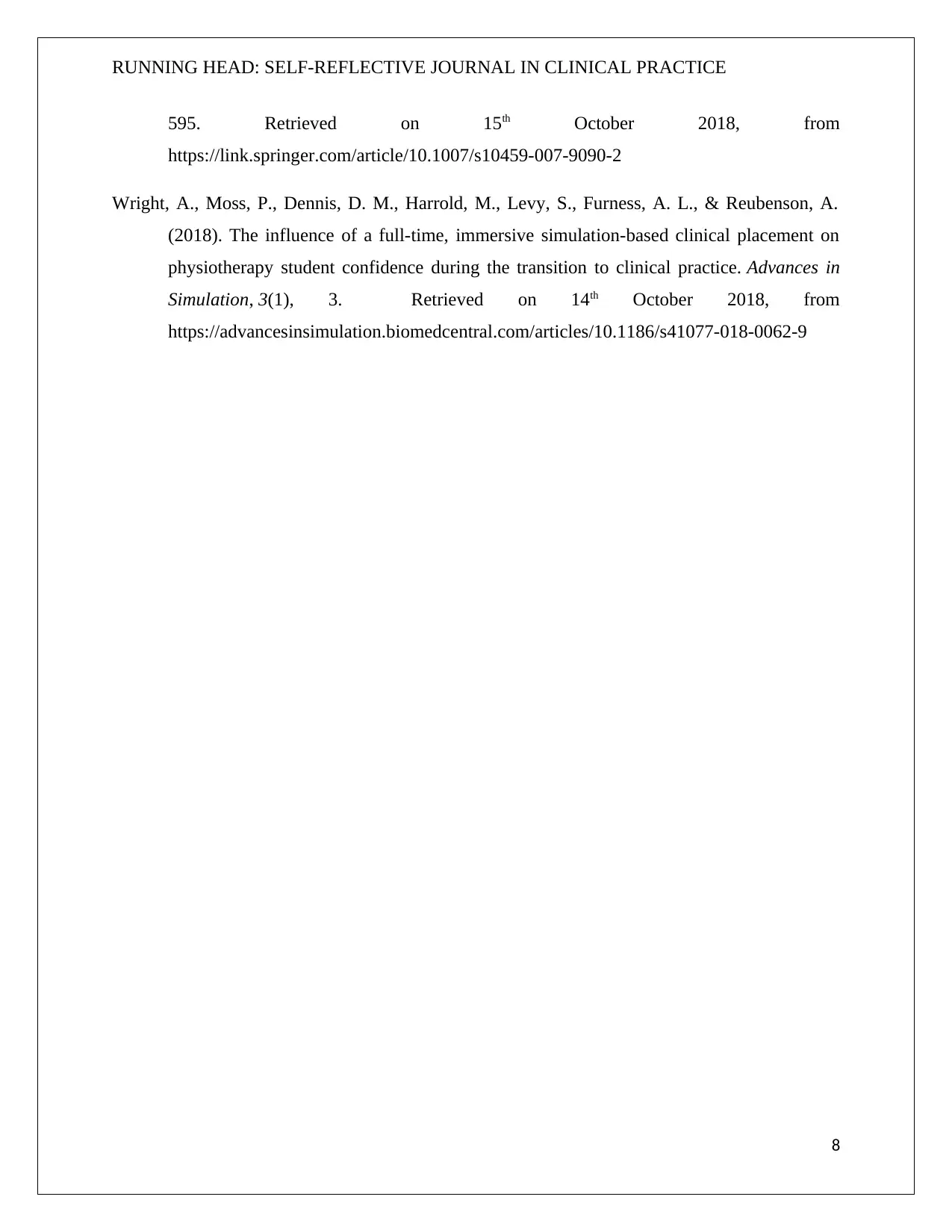
RUNNING HEAD: SELF-REFLECTIVE JOURNAL IN CLINICAL PRACTICE
595. Retrieved on 15th October 2018, from
https://link.springer.com/article/10.1007/s10459-007-9090-2
Wright, A., Moss, P., Dennis, D. M., Harrold, M., Levy, S., Furness, A. L., & Reubenson, A.
(2018). The influence of a full-time, immersive simulation-based clinical placement on
physiotherapy student confidence during the transition to clinical practice. Advances in
Simulation, 3(1), 3. Retrieved on 14th October 2018, from
https://advancesinsimulation.biomedcentral.com/articles/10.1186/s41077-018-0062-9
8
595. Retrieved on 15th October 2018, from
https://link.springer.com/article/10.1007/s10459-007-9090-2
Wright, A., Moss, P., Dennis, D. M., Harrold, M., Levy, S., Furness, A. L., & Reubenson, A.
(2018). The influence of a full-time, immersive simulation-based clinical placement on
physiotherapy student confidence during the transition to clinical practice. Advances in
Simulation, 3(1), 3. Retrieved on 14th October 2018, from
https://advancesinsimulation.biomedcentral.com/articles/10.1186/s41077-018-0062-9
8
1 out of 8
Related Documents
Your All-in-One AI-Powered Toolkit for Academic Success.
+13062052269
info@desklib.com
Available 24*7 on WhatsApp / Email
![[object Object]](/_next/static/media/star-bottom.7253800d.svg)
Unlock your academic potential
Copyright © 2020–2025 A2Z Services. All Rights Reserved. Developed and managed by ZUCOL.




